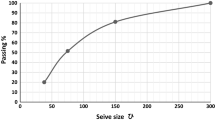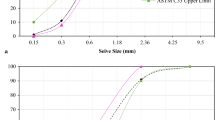Abstract
Polymer modification was widely used to improve the properties of construction materials. The concept of polymer modification for mortar and concrete was put forward 80 years ago. It was known that the use of polymers for modification can greatly improve the strength, adhesion, resilience, impermeability, chemical resistance and durability properties of mortars and concrete. In southern Vietnam, a tropical weather country, the environment was usually hot with high humidity. The durability of mortar or concrete coating was reduced over time in such a condition. This study examines the strength of polymer-modified mortars in high temperature and high humidity. Moreover, the results included the improvement of strength of acrylic emulsion polymer-modified mortar (PMM) by the addition of blast furnace slag. Fifteen percent cement was replaced with blast furnace slag (BFS) in a mix proportion in order to improve strength of PMM. The specimens were cured in cycles 50±2°C, RH 90±3%, for 5 hours and 20±2°C, RH 60±3 %, for 19 hours per day. The strength of PMM was measured at the age of 3, 7, 14, 21 and 28 days, 3 and 6 months and 1 year in a high temperature and high humidity cycles.
Similar content being viewed by others
References
ASTM C 109/C109M-99.
ASTM C 348-97.
ASTM C 496-96.
Chandra, S. and Ohama, Y. (1994). Polymers in concrete, CRC Press, Inc.
Ding, S.H., Liu, D.Z., and Duan, L.L. (2006). “Accelerated aging and aging mechanism of acrylic sealant.” Polymer Degradation and Stability, Vol. 91, pp. 1010–1016.
Hassan, K.E., Robery, P.C., and Al-Alawi, L. (2002). “Effect of hot-dry curing environment on the intrinsic properties of repair materials.” Cement and Concrete Composites, Vol. 22, pp. 453–458.
Hassan, K.E., Brooks, J.J., and Alawi, L.A. (2001). “Compatibility of repair mortars with concrete in a hot dry environment.” Cement and Concrete Composites, Vol. 23, pp. 93–101.
Information Center of Natural Resources and Environment, Ministry of Resources and Environment. http://www.ciren.gov.vn/index.php?newlang=englwash
Jenni, A., Zurbriggen, R., Holzer, L., and Herwegh, M. (2002). “Changes in microstructure and physical properties of polymer-modified mortars during wet storage.” Cement and Concrete Research, Vol. 36, pp. 79–90.
Mirza, J., Mirza, M.S., and Lapointe, R. (2002). “Laboratory and filesd performance of polymer-modified cement based repair mortars in cold climates.“ Construction and Building Materials, Vol. 16, pp. 365–374.
Neville, A.M. (1996). Properties of concrete, 4th and Final Ed., John Wiley & Son, Inc.
Ohama, Y. (1995).Handbook of polymer modified concrete and mortars, Noyes Publications.
Ru, K., Zhang, D., and Song, J.M. (2002). “Properties of polymer modified cement mortar using pre-enveloping method.” Cement and Concrete research, Vol. 32, pp. 425–429.
Tobing, S.D. and Klein, A. (2000). “Mechanistic studies in Tackified acrylic emulsion pressure sensitive adhesives.” Applied Polymer Science, Vol. 76, pp. 1965–1976.
Author information
Authors and Affiliations
Corresponding author
Rights and permissions
About this article
Cite this article
Kwon, HM., Nguyen, T.N. & Le, T.A. Improvement of the strength of acrylic emulsion polymer-modified mortar in high temperature and high humidity by blast furnace slag. KSCE J Civ Eng 13, 23–30 (2009). https://doi.org/10.1007/s12205-009-0023-x
Received:
Revised:
Accepted:
Published:
Issue Date:
DOI: https://doi.org/10.1007/s12205-009-0023-x




